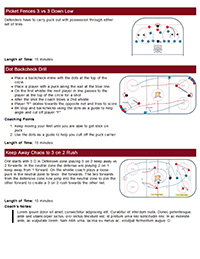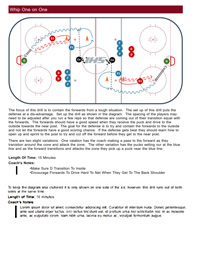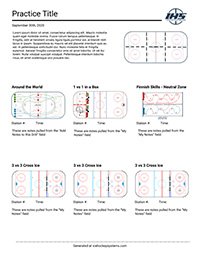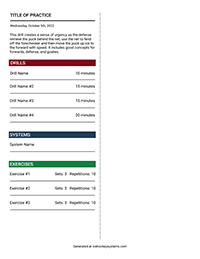Body Contact & Checking Practice # 1 of 5
Body Contact & Checking Practice # 1 of 5

Friday, August 4th, 2023
Practice Notes
This is Practice # 1 of 5 from the Body Contact & Checking Course created by Mark Zarbo Hockey.
Practice # 1 Overview
Coach's Notes:
The purpose of practice #1 is to teach all the basics of checking. Day #1 is meant to be slow and controlled to give the players the ability to feel their way through this new skill and overcome any fears they might have.
- Starts with focusing on base of support and staying low.
- Followed by a basic checking mechanics drill.
- Next, we dive into the idea that the best way to protect yourself and the puck is hit the player before they hit you.
- After that we move into boards checking and hitting through a player's hands to separate them from the puck.
- Then lastly, we finish with a simple drill that stresses the 2 purposes checking.
1 v 1 Stick Battle

Details:
Drill Setup:
- Players are partnered together with 1 stick between them.
- On whistle players battle trying knock their partner down.
- Rules are no twisting the stick to knock your partner down and if you are your partner get knocked down you must get right back up and start again.
- Drill should be done10 - 20 seconds, 3 - 4 reps.
- Note, for safety coach should have players more toward the middle of the rink and not near the wall.
Drill Purpose:
- This drill is meant to be a warm up drill lto get players ready for some contact, have a little competitive fun and lighten the mood.
- When it comes to checking many players are nervous and some fearful so this is a good drill to break a little of that. In addition, this drill should be used to talk about the importance of posture, base of support and staying low.
This drill is part of the Body Contact & Checking Course from Mark Zarbo Hockey.
Side by Side Checking

Details:
Drill Setup:
- Players should partner with someone of their size.
- Players will stand still next to each other. Focusing on good mechanics, 1 of the players or a coach counts to 3.
- On the count of 3, the two players hit each other. Players continue to repeat this until coach stops them or tells them to switch sides.
- This drill is meant to be slow and controlled way to allow the players to feel out the skill of checking.
Drill Purpose:
- One, allow players the chance to feel out the skill of checking. Continue to build confidence and get over any nervousness/fear of how it will feel.
- Two, give players a controlled way to focus on some of the basic mechanics of checking. Start with good base of support (feet just wider then shoulder width), good low posture, load the opposite leg (leg opposite from where the player they are checking is), use good weight shift to create power to hit (start low, finish low- mirror image), lead with your shoulder & follow through with hip, keep head & chest up, hit with the side of the shoulder (not the front or back of shoulder).
- With this drill there are a lot of little details you can dive into allow players a chance to work through and feel them out. I tend to take my tim ewith this drill and perform the drill until I think all the players look comfortable checking.
Variations:
- Suggestion is to start this drill without a stick. By starting the drill without using sticks you are forcing the players to be balanced over their skates and not able to us their stick for balance. Good way for players to star t to figure out that balance.
- Once proficiency is shown you can give the players their sticks back and/or even have the players both have a puck on their stick. What you will usually see is, when the players start using their sticks they will go back to bad habits of leaning on their stick or being bent forward and not keeping head/chestup as they should.
- Once players are proficient with having a stick can perform the same drill with each player having a puck. This starts to introduce the skill of hitting and controlling the puck at the same time. Suggestion is 3 - 5 minutes no stick, 3 - 5 minutes with a stick, 3 - 5 minutes with stick and puck.
Common Mistakes:
- Many players are unable to perform proper weight shifts or don't have the leg strength for to weight shift, so they tend to lean on their pants with their elbows. For this one I que these players to not lean on their pants. These players could use more leg strength, balance drills and practice at weight shifting in general.
- Players that are bent too much at the waste will start in good position and then when they go to hit will"break" at the waste putting themselves off balance and in vulnerable position (head in front). For this I will put my hand on these players chest and tell them to not push into my hand. I will have them do the drill a few times with my hand on their chest and then que them to imagine my hand is their and do reps with out my on their chest.
- Players will drop their shoulder or lead with their head. This mistake leads to these players getting hit in the head. These players need to be queued to lead with their shoulder. If proper form player shouldn't be hit in he head. The head stays protected between their shoulders.
- Getting hit on or using the front or back of the shoulder to hit. This mistake is easy to pick out because if a player gets hit on or hits with the back of the shoulder they tend to get pushed forward by their opponent. Vice Versa of the player rotates and hits with the front side of their shoulder they tend to get pushed or fall backwards. Correct the player to hit with the side/shoulder cap as this is the strongest part.
- Hitting softly. I usually let the players who are hitting softly do so for a little bit to feel out the skills. Once I think they are looking more comfortable I now que them to hit as hard as they can. Practice creating power and build confidence that they will be use with checking. Being this drill is done standing still side by side, players are not able to create a lot of force so this is a good time to do that. Players who are hitting softly are usually the ones who are nervous or fear about checking. These players have to understand that not using their full strength force will get them injured more so then putting their whole body/strength into it.
USA Step Forward Drill

Details:
Drill Setup:
- Players split into groups of 3-4. If 3 players then a coach will have to be the one pointing. Use a dot for the drill as it is a good reference to tell X2 if they"stepped forward"or not. X1is the pointer. X2 is the player "stepping forward" & reacting to an on coming check. X3 and X4 are the ones watching X1. If X1 points at them they skate in and hit X2.
- It should only be ~1 stride length between X2 and X3 - 4. Players should not be able to take multiple strides or charge X2. For the drill X1 is pointing at either X3 o rX4.
- Whoever X1 points at skates in and hits X2. X2 has to have eyes on both players, be ready (light on skates) and react by stepping forward into the check.
- If done correctly X2 finishes off the dot. After this hi tX2 goes back to the dot and gets ready for the next hit. X2 is not allowed to look at X1 or see who they are pointing at.
- We want this to be an organic reaction to step forward and hit an oncoming checker.
- After 4-5 total hits the players should rotate spots.
Drill Purpose:
- The purpose of this drill is introduce the concept that the best way to protect yourself when getting hit is to hit the other player stand/or step into their hit.
- By stepping forward into their hit you throw off the opposing players timing and help to absorb their hit. This means the opposing player will be unable to hit you as hard as they can effectively protecting yourself from the hit.
- In addition, if you have the puck, it will also allow you to protect the puck and keep possession of it as well (reverse hit).
- We want X2 to start developing there reaction that when someone comes to hit you, you do not just stand still and take a hit, you step at them and give the hit.
Variations:
- Perform this drill to start without a stick to allow players to work on their balance with checking. Then you can move into players having their sticks and X2 having a puck.
- When X2 has a puck now you are introducing the 2 reasons we hit.
- One, when you don't have the puck you can use checking to separate your opponent from the puck and take it.
- Two, when you have the puck you can use checking to protect yourself and the puck.
- For the drill when X2 has the puck now they are practicing hitting and maintaining control of the puck at the same time. For many players this is a tough skill (doing multiple things at once). ForthedrillX3andX4arenottryingtotakethepuck. It is just meant for X2 to practice initiating contact and maintaining puck control.
Common Mistakes:
- X2 does not step forward off the dot. This is why we use the dot as it is a visual que for the player if they moved or not. This is the most important part of the drill. Step forward into the on coming checker.
- Leaving your chest open/getting hit in the chest. This mistake could be made by any of the checking players X2, 3 or 4. If they do not rotate to hit/lead with their shoulder then they leave their chest open. Easy mistake to pick out / self correct. If a player gets knocked backwards they should be queued they left their chest open.
- X2 using the same shoulder to hit both X3-4. X2 should use both shoulders. If player is coming from their right, X2 should use their right shoulder to hit. If a player is doing this it shows they have a dominate side. They might need more work on their weak side to become more comfortable with checking and the motion on that side.
- Stepping into the oncoming checker but not actually hitting them. There are players who will step forward toward the hit but they will not actually hit the player. They just step forward and then take the hit. We need them to step forward and at the same time throw a hit themselves. Take these players aside and work on this in slow motion. It usually is just a coordination patterning issue that they need to work through or being able to step forward AND hit at the same time.
- Look for all the same minor mistakes from side by side checking. Not loading using weight shift to create power. Leading with their head or shoulder or bending at the waste to much. Not following through with their hit.
Hit Through the Hands

Details:
Drill Setup:
- 2 lines in the same corner.
- Line against the wall has pucks. Line in the middle no pucks.
- X1 skates up the wall with the puck about half speed.
- X2 skates up along side the man and hits through the hands separating X1 from the puck and stopping their forward motion.
- After the hit., X2 lets X1 go and X1 grabs the puck again skating up the wall. X2 repeats hitting through the hands.
- Players perform this to the desired spot of stopping the drill. This drill is meant to be slow and controlled to allow players to feel out the skills in the drill.
Drill Purpose:
- This drill has 2 main purposes. One, teach X1 (player against the wall) how to stay near the wall and use the wall to absorb hits. Coach should talk about what the danger zone is and how we don't want to be just off the wall.
- Injuries are more common from players getting hit and then falling into boards awkwardly. If the player is against the wall then the chance of injury is reduced as now the wall can absorb the hit and they won't fall awkwardly into it. Two, introduce the concept of hitting through the hands of the player. This is an important skill to learn as it is what will help separate the opposing player from the puck.
- This skill is also the last part of teaching angling. As player angles the opposing player up the wall giving them only 1 place to skate to and then cuts them off hitting through the hands. Other skills to focus on are as X2 is hitting through the hands they should be using a stick lift or poke to also help separate the opposing player from the puck.
- Common saying to use is "Stick on Stick, Body on Body."
Common Mistakes:
- One, with this drill are X1 coming off the wall and then they get hit by the player and then also hit / fall into the wall. Que them to stay near boards and use wall to absorb the hit.
- Two, X2 hits X1 on the side and doesn't hit through their hands. By just hitting them on the side you are not stopping their forward motion and/or not separating them from the puck. For the drill you want to see X2 completely stop X1's forward motion before they repeat the drill down the wall.
- Three, X2onlygoingforthepuckoronlygoingforthebody. We want to see X2 hit through the hands AND use a stick lift or poke to also take the puck away. These two things are done simultaneously.
1 v 1 Circle (Stick vs. No Stick)

Details:
Drill Setup:
- 2 players go into the circle. One player has a stick and puck.
- The other player does not have a stick.
- When coach says go it is keep away / 1v1. The player with the stick and puck is trying to control the puck, while the player without the puck is trying to knock the other player off the puck.
- If the player without the puck knocks the player off the puck it is a new puck to the player with the stick. Player without a stick is also not allowed to kick the puck.
- By taking the stick away from one of the players you are forcing them to have to play the body. If both players have their sticks they tend to use little to no body contact.
- Play until coach says switch.
Drill Purpose:
- The purpose of this drill is it a very basic semi uncontrolled way to practice the two purposes of checking. These are if you do not have the puck to seperate the opposing player from the puck. If you do have the puck use checking to protect the puck and yourself. For the player without a stick you can start to talk about using angling and pushing the player with the puck 1 direction to allow you to skate along side of them and use your body to hit them. Can also talk about trying to read the offensive player body language for what they might do. You have to be ready for them to change directions!
- For the player with the puck/stick you can talk about a variety of skills.
- One, using a bump & go. This is the player with the puck draws the player without the puck close to them. As they get close the player with the puck throws an offensive hit to try and"stun"the defending player. After this hit the offensive player now uses an escape turn to accelerate away.
- Two, offensive player can start to use fake/deceptive turns to try and throw off the defenders angle.
- Three, talk about using changes of speed to throw off the defender.
Variations:
- Once the players start to show some proficiency and willingness in using their body you can give the defender a stick turned upside down.
- The defender still isn't worried about the puck but now you can start introducing concepts of using your stick to steer the offensive player as well as using your stick and body together to separate the offensive player from the puck (stick on stick, body on body).
- Once the players show proficiency in that version of the drill then it can become 1 v 1keep in the circle. Both players have sticks.
- Can make it a competition in a few different ways. Every steal by the defender is worth 1 point. If the player uses good form and body contact to create the steal that is worth 2 points. This point system encourages contact and encourages the player to nd a way to steal the puck.
- It also encourages the offensive player not to lose the puck or else that is a point against them.
- Always make sure to have something on the line that the players are playing for! That always brings more intensity and effort to a drill!
Common Mistakes:
This drill is where you can see alot of bad habit mistakes such as:
- Looking down at the puck and not taking the body
- Stopping facing or turning into the defender exposing the puck and/or your chest to a hit.
- Turning and exposing your back to a defender coming to hit you (big no-no, leaves you open to hit from behind).
Coach's Notes:
- View Course Overview
- Practice # 1 - Learning The Basics (Currently Viewing)
- Practice # 2 - Weight Shifting & Playing In Contact
- Practice # 3 - Puck Protection & Intro To Angling
- Practice # 4 - The Skill of Angling & Creating Turnovers
- Practice # 5 - Defensive Footwork, Angling & Body Contact
A special thank you to Mark Zarbo for creating this course for the IHS community. Make sure to visit Mark Zarbo's Contributor page to learn more, and connect with Mark.



